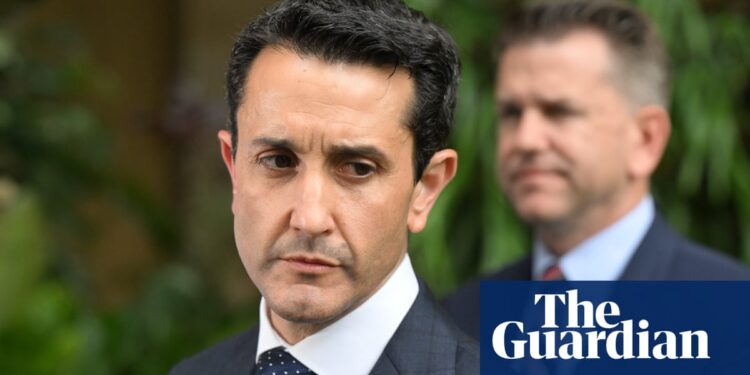The story of the Queensland election is the story of Mackay and Mansfield.
The voters of Mackay stuck with Labor during the landslide loss to Campbell Newman’s Liberal National party in 2012. They voted for the party in the “Adani election” of 2017, at the nadir of the state’s climate wars.
In Mansfield, in Brisbane’s southern suburbs, locals backed Newman’s LNP in 2015, when that government was sensationally chucked from office, tossing away the country’s largest ever majority in a single term.
It took a decade for the LNP to come back to power. David Crisafulli is the new premier, but he leads a state cleaved in two.
On Saturday night, Crisafulli won decisively in the regions but was largely rejected by the city. He won Mackay, but couldn’t crack Mansfield.
The political realignment will have long-term consequences for the new government, the Labor opposition and their federal counterparts.
It is true, on some level, that Queensland is Australia’s most conservative state. But at the same time, Brisbane is a modern and progressive city.
The state’s politics in many ways is beginning to follow the American trend, leaning leftwards in urban areas, and to the right as you move through the outer suburbs and into the regions.
In Queensland, Labor could always count on its working-class regional strongholds: Mackay, Rockhampton and Gladstone. Only the latter remains and even in Gladstone – which has a strong union culture – there was a 15% swing away from Labor.
Crisafulli’s path to a majority began in Townsville and continued through central Queensland, via Maryborough, the Sunshine Coast and Brisbane’s northern fringes. That was enough for a small majority, but the gains almost stopped dead when the blue march reached the city.
The Liberal vote stalled in inner-city areas, helping Labor win seats that had been targeted by the Greens.
The LNP is able to win Brisbane at council level, but when it comes to state elections, voters tend to get scared off by the hard-right social views of some candidates. The campaign’s shift to focus on abortion rights sheeted that home. Labor’s popular 50c public transport fares would have also buttressed its support in the city.
For Crisafulli and the LNP, the only way to defend its majority over the next four years will be to show Brisbane people the moderate government they thought they were getting when Campbell Newman was elected in 2012.
He will have to fight off any attempt to revive culture wars (on abortion and trans rights), energy wars (via nuclear), and find a way to appeal to the sensitivities of voters who would, with good reason, have concern about the signal sent if the LNP were to follow through on promises to cancel the state’s path to treaty process with First Nations people.
Greens risk losing both their seats
The Queensland election was unquestionably a bad result for the Greens – the party looks like it might lose both its state seats.
Commentators on Saturday night were tempted to overlay national issues on to Queensland to explain the Greens’ losses as a rejection of the Max Chandler-Mather version of the federal party that has felt more abrasive as it muscles in on debates about housing, Palestine and other issues.
That might be the case, to some extent, in Maiwar, where Michael Berkman is unexpectedly in trouble.
Berkman, a former environmental lawyer, is hardworking and popular in an area – around Toowong and Indooroopilly – that is the traditional home of Queensland’s small-L liberals.
after newsletter promotion
The absence of vitriolic “climate wars” that have marked Queensland politics for decades will not have helped the Greens in Maiwar and elsewhere.
In Cooper, McConnel and South Brisbane, the Greens’ vote went backwards, but not to a dire extent. Those seats were won easily by Labor not because of a Greens collapse, but because they became progressive versus progressive contests, where the LNP ran a pitiful third and decided the result via preferences.
Those places show a paradox that could hamper the Greens’ growth as a housing-focused political movement championed by Chandler-Mather. Many people here are the sorts of affluent lefties who gave the environmental party a foothold in the first place. Many young and angry voters now targeted by the Green movement have been supplanted into the next ring of suburbs, where rents are much cheaper.
In the next layer of seats further out, there were swings to the Greens – Greenslopes (3.1%), Miller (2.1%), Ferny Grove (4.1%), Inala (3.8%), Stretton (5.3%) and Woodridge (6.5%).
The risk for the party is writ large in the disaster of possibly losing both its seats – and in the process any representation in the Queensland parliament.
The Labor-Greens war on the left of Australian politics is often fought by the forces of the perfect world and those who say they need to compromise to win power and actually get things done.
So, if the Greens aim is to change the world – and not necessarily a political one – they’ve succeeded here.
The Labor party that stole votes from the Greens is one that adopted its policies – on public transport, free school lunches and mining taxes – and these proved popular.
Voters who might have backed the Greens saw in Labor, for the first time in decades, a party willing to campaign on transformative – dare we say “socialist” – policies. To put social issues like abortion front and centre.
While there will be inquests within the Greens, the reality could be that the party’s future is, as much as anything else, in Labor’s hands. Where does Labor pivot now? Does it lean into popular progressive policies? Or does it shift again to try to win back Townsville, Mackay and Rockhampton?
After all, just like the LNP, Labor has to figure out a way to win both Queenslands – in the city and the regions.






